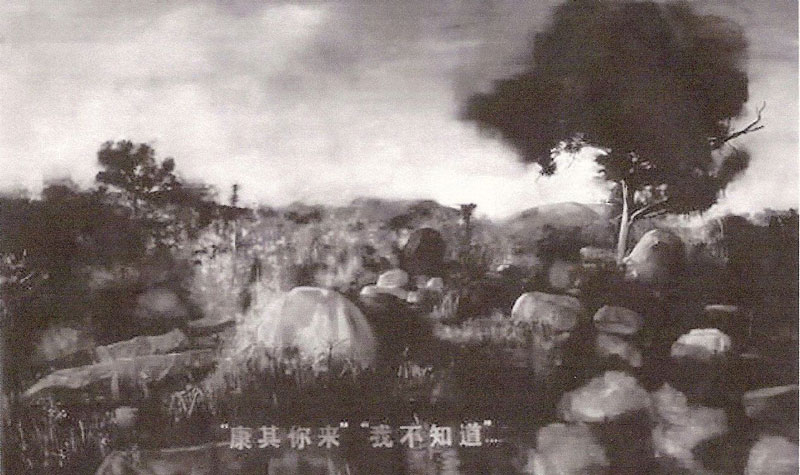Contemporary Chinese Art- another kind of view
DSL Collection
Li Dafang, Twang, Oil on Canvas, 300cm x 480 cm, 2003
"Among a field of large boulders, two figures facing each other over some distance are more guessed than seen by the viewer. With its sub-title-like caption, the painting might be taken for the photorealistic interpretation of a TV-screenshot, was it not for the detailed composition that one hardly would find on TV.
Nevertheless, the connection to moving images is not as far out as it seems. Li Dafang sees himself as a director, bringing to the surface of a canvas what others would ban on celluloid. He is a known composer of mildly absurd scenes where he combines realistic backgrounds with human figures carrying out strangely erratic tasks. Li regards himself as a craftsman rather than as an artist who uses his skill to communicate himself to the outside world and frequently re-adapts his style of painting to keep up with his changing moods. While earlier using an intensively colorful style, resembling a combination of French pointillism and post World War I German tendencies, he moved on to his present mode of blurred surfaces in 2003, skipping the practice of adding written captions in 2005. To Li an image?s content, the caption and the work?s title form an inseparable whole. This is particularly so in Twang, a work that can only be understood when knowing the story behind. According to Li, it is about two friends who lived far away from each other and kept in touch by playing the Chinese zither guqin. The caption reads ?Kang Qi come over? ?I don?t know?. Kang has been the given name of Xi Kang a famous musician of the fourth century A.D. and author of a long poem on the guqin, while the story, Li tells of his work, reminds of Boya and Zhong Zhiqi, two legendary friends of China?s antique, who understood each other wordlessly, only by listening to their guqin music. When Zhiqi died, Boya broke his instrument never to play again.
Unlike his other paintings, which are clearly located in the present, Twang is timeless. What one sees could happen anytime anyplace. It is a perfect example of the working style of Li Dafang, who alludes to legends to communicate his complex semi-real inner world while at the same time offering the viewer a space of his or her own within this world."
Christoff Buettner
"Among a field of large boulders, two figures facing each other over some distance are more guessed than seen by the viewer. With its sub-title-like caption, the painting might be taken for the photorealistic interpretation of a TV-screenshot, was it not for the detailed composition that one hardly would find on TV.
Nevertheless, the connection to moving images is not as far out as it seems. Li Dafang sees himself as a director, bringing to the surface of a canvas what others would ban on celluloid. He is a known composer of mildly absurd scenes where he combines realistic backgrounds with human figures carrying out strangely erratic tasks. Li regards himself as a craftsman rather than as an artist who uses his skill to communicate himself to the outside world and frequently re-adapts his style of painting to keep up with his changing moods. While earlier using an intensively colorful style, resembling a combination of French pointillism and post World War I German tendencies, he moved on to his present mode of blurred surfaces in 2003, skipping the practice of adding written captions in 2005. To Li an image?s content, the caption and the work?s title form an inseparable whole. This is particularly so in Twang, a work that can only be understood when knowing the story behind. According to Li, it is about two friends who lived far away from each other and kept in touch by playing the Chinese zither guqin. The caption reads ?Kang Qi come over? ?I don?t know?. Kang has been the given name of Xi Kang a famous musician of the fourth century A.D. and author of a long poem on the guqin, while the story, Li tells of his work, reminds of Boya and Zhong Zhiqi, two legendary friends of China?s antique, who understood each other wordlessly, only by listening to their guqin music. When Zhiqi died, Boya broke his instrument never to play again.
Unlike his other paintings, which are clearly located in the present, Twang is timeless. What one sees could happen anytime anyplace. It is a perfect example of the working style of Li Dafang, who alludes to legends to communicate his complex semi-real inner world while at the same time offering the viewer a space of his or her own within this world."
Christoff Buettner

